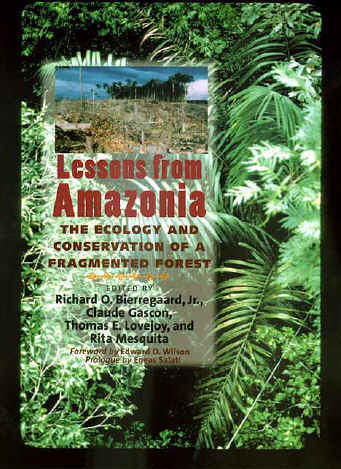


 |
Lessons
from Amazonia: The Ecology and Conservation of a Fragmented Forest
R. O. Bierregaard, Jr., C. Gascon, T. E. Lovejoy, and R. Mesquita, Editors Submitted
to Yale University Press on 6 August 1998 Contact Yale University Press to order the book
|
This volume is a collection of reports on two decades of research by the students
and researchers of the Biological Dynamics of Forest Fragments Project. It is our attempt
to distill what we have learned into conservation and management guidelines that can be
put to use on the ground in the richest terrestrial ecosystem on the planet.
Contents
Preface. The Editors
Foreword by Edward O. Wilson
Prologue by Eneas Salati
Part I - Theory and Overview
Introduction - Richard O. Bierregaard, Jr., and Claude Gascon.
Chapter 1. The Biological Dynamics of Forest Fragments Project: Overview and History of a Long-Term Conservation Project. Richard O. Bierregaard, Jr., and Claude Gascon.
Chapter 2. A Theoretical Overview of the Processes Determining Species Richness in Forest Fragments. Og DeSouza, José H. Schoereder, Valerie Brown, and Richard O. Bierregaard, Jr. (Read the abstract)
Chapter 3. Deforestation and Forest Fragmentation in the Amazon. Claude Gascon, Richard O. Bierregaard, Jr., William F. Laurance, and Judy Rankin-de Mérona.
Chapter 4. The Biological Dynamics of Forest Fragments Project: The Study Site, Experimental Design, and Research Activity. Claude Gascon and Richard O. Bierregaard, Jr.
Part II - Forest Ecology and Genetics
Introduction - Richard O. Bierregaard, Jr., and Claude Gascon.
Chapter 5. The Hyper-diverse Flora of the Central Amazon: An Overview. William F. Laurance. (Read the abstract)
Chapter 6. Lecythidaceae of a Central Amazonian Lowland Forest: Implications for Conservation. Scott Mori, Peter Becker, and Dwight Kincaid. (Read the abstract)
Chapter 7. Tree Age Structure in Tropical Forests of Central Amazonia. Jeffrey Chambers.
Chapter 8. The Genetics Of Rare Tropical Trees: Implications for Conservation of a Demographically Heterogeneous Group. Nadja Lepsch-Cunha, Claude Gascon, and Paulo Kageyama.
Part III - Fragmentation Effects
Introduction - Richard O. Bierregaard, Jr., and Claude Gascon
Plant Communities
Introduction - Richard O. Bierregaard, Jr., and Claude Gascon
Chapter 9. Deforestation Impact at the Edge of an Amazonian Forest Fragment: Tree Mortality, Damage, and Recruitment. Judy Rankin-de Mérona and Roger W. Hutchings H.
Chapter 10. Effects of Landscape Fragmentation on Palm Communities. Aldicir Scariot. (Read the abstract)
Chapter 11. Regeneration in Tropical Rainforest Fragments. Julieta Benitez-Malvido. (Read the abstract)
Chapter 12. Habitat change, African honeybees, and fecundity in the Amazonian tree Dinizia excelsa (Fabaceae). Christopher Dick.
Chapter 13. Fragmentation and Plant Communities: Synthesis and Implications for Landscape Management. William F. Laurance. (Read the abstract)
Invertebrates
Introduction -- Richard O. Bierregaard, Jr., and Claude Gascon.
Chapter 14. Drosophilid Fruit-fly Guilds in Forest Fragments. Marlúcia B. Martins.
Chapter 15. Local Extinction Risks and Asynchronies: The Evidence for a Metapopulation Dynamics of a Social Spider, Anelosimus eximius (Araneae, Theridiidae). Eduardo M. Venticinque and Harold G. Fowler.
Chapter 16. Landscape Modifications and Ant Communities. Heraldo L. Vasconcelos, Karine S. Carvalho, and Jacques H. C. Delabie. (Read the abstract)
Chapter 17. Stingless Bees (Meliponini) and Orchid Bees (Euglossini) in Terra Firme Tropical Forests and Forest Fragments. Márcio Luiz de Oliveira.
Chapter 18. The Implications of Changing Invertebrate Abundance Patterns for Insectivorous Vertebrates in a Fragmented Forest in Central Amazonia. Raphael Didham.
Vertebrates
Introduction -- Richard O. Bierregaard, Jr., and Claude Gascon
Chapter 19. Community Composition and Breeding Success of Amazonian Frogs in Continuous Forest and Matrix-habitat Aquatic Sites. Mandy D. Tocher, Claude Gascon, and Joel Meyer.
Chapter
20. Conservation Recommendations for Understory Birds in Amazonian Forest
Fragments and Second Growth Areas. Philip C. Stouffer and Sérgio H. Borges.
Chapter
21. Primates in a Fragmented Landscape: Six Species in Central Amazonia.
Kellen A. Gilbert and Eleonore Z. F. Setz.
Chapter
22. The Brown Capuchin Monkey (Cebus apella): Ecology and Home Range
Requirements in Central Amazonia. Wilson R. Spironello.
Part IV - Management Guidelines
Introduction -- Richard O. Bierregaard, Jr., and Claude Gascon.
Chapter 23. Soil and Development in Amazonia: Lessons from the Biological Dynamics of Forest Fragments Project. Philip M. Fearnside and Niwton Leal Filho.
Chapter 24. Forest Restoration in Abandoned Pastures of Central Amazonia. Gislene Ganade.
Chapter 25. Effects of Fire on Rain Forest Regeneration in the Amazon Basin. G. Bruce Williamson and Rita C. G. Mesquita.
Chapter 26. Selective Logging in the Brazilian Amazon: Its Relationship to Deforestation and the International Tropical Hardwood Market. Niro Higuchi. (Read the abstract)
Chapter 27. Extending Models of Edge Effects to Diverse Landscape Configurations, with a Neotropical Test Case. Jay R. Malcolm.
Chapter 28. Characterizing the Changing Spatial Structure of the Landscape. Miles G. Logsdon, Valerie Kapos, and John B. Adams.
Part V - Synthesis
Chapter 29. Principles of Forest Fragmentation and Conservation in the Amazon. Richard O. Bierregaard, Jr., William F. Laurance, Claude Gascon, Julieta Benitez-Malvido, Philip M. Fearnside, Carlos R. Fonseca, Gislene Ganade, Jay R. Malcolm, Marlúcia B. Martins, Scott Mori, Márcio Oliveira, J. Rankin-de Mérona, Aldicir Scariot, Wilson Spironello, and Bruce Williamson.
![]()
Top - Home - Habitat Fragmentation - Neotropical Birds - Birds of Prey - Project Osprey Watch - Project Barn Owl - Graduate Students - Conservation Organizations - Publications